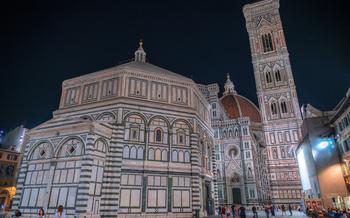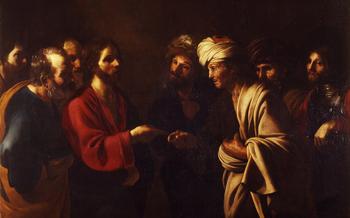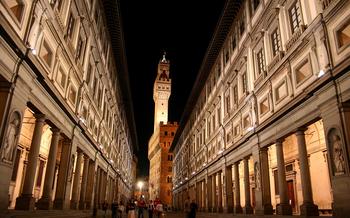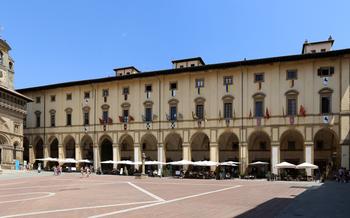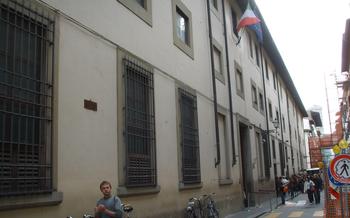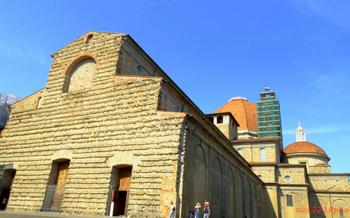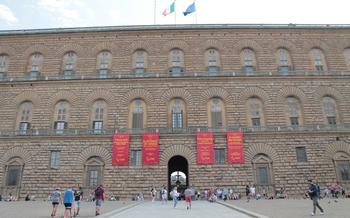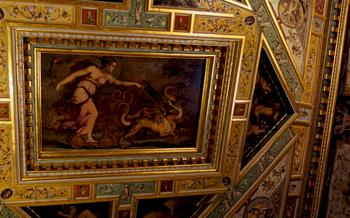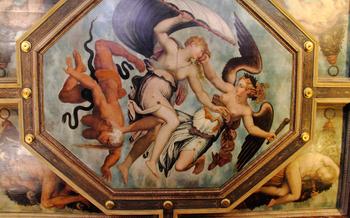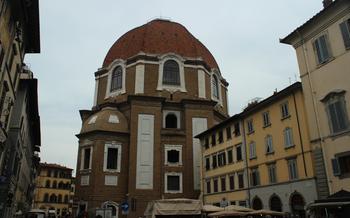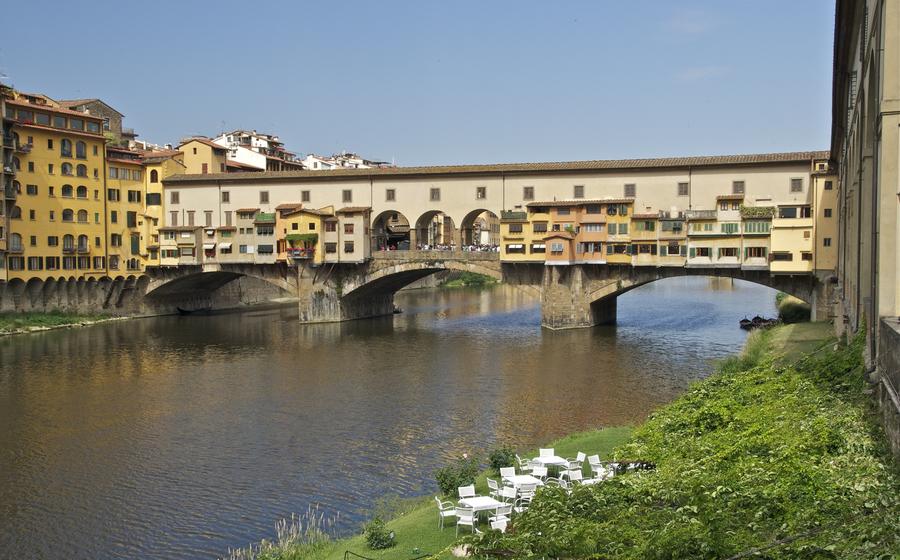
Ponte Vecchio
- Introduction
- History of the Ponte Vecchio
- The Vasari Corridor
- History
- Description
- Function
- Anecdote
- The Views from the Ponte Vecchio
- Crossing the Ponte Vecchio
- The Ponte Vecchio in Art
- The Ponte Vecchio and Fashion
- The Ponte Vecchio and History
- Visiting the Ponte Vecchio
- The Ponte Vecchio and Music
- Insider Tip: Unveil the Secret Courtyard of Palazzo Guadagni
Introduction
The Ponte Vecchio, an emblem of Florence, is not merely a bridge but a work of art, deeply imbued with history and cultural significance. Nestled in the heart of the city, this ancient crossing spans the Arno River, connecting the Uffizi Gallery to the Palazzo Pitti. Its unique construction, with shops lining both sides of the bridge, has made it a symbol of Florentine ingenuity and a must-visit destination for travelers worldwide.
The Ponte Vecchio is more than just a bridge; it is a living testament to the city's rich past, a vibrant marketplace, and an architectural marvel. With its goldsmith shops, art galleries, and souvenir vendors, it offers a unique shopping experience that blends traditional craftsmanship with modern-day vibrancy. Its history is intertwined with the Medici family, the powerful dynasty that ruled Florence during the Renaissance, and its survival through World War II stands as a testament to its enduring resilience.
As you stroll across the Ponte Vecchio, take a moment to soak in its beauty, its history, and its vibrant energy. It is a bridge that truly captures the essence of Florence, a city where art, history, and culture converge in a harmonious symphony.
History of the Ponte Vecchio
The Ponte Vecchio, with its distinctive shops lining both sides, is a testament to Florence's rich history and enduring charm. Its origins date back to Roman times when a wooden bridge spanned the Arno River at this strategic location. However, the current stone structure was built in 1345 by Taddeo Gaddi, a pupil of the renowned artist Giotto.
Over the centuries, the Ponte Vecchio has undergone several modifications and renovations. In 1565, Giorgio Vasari, under the patronage of the Medici family, added the Vasari Corridor, an enclosed elevated passageway that connected the Palazzo Vecchio with the Palazzo Pitti, allowing the Medici to move between their residences without venturing into the crowded streets.
The Ponte Vecchio played a crucial role in Florence's history. During the devastating flood of 1333, it was one of the few bridges that remained standing, demonstrating its remarkable resilience. In World War II, when most of Florence's bridges were destroyed, the Ponte Vecchio was spared due to the intervention of German Consul Gerhard Wolf, who defied orders to demolish it.
Today, the Ponte Vecchio stands as a symbol of Florence's resilience and architectural heritage. It is a testament to the city's ability to preserve its past while embracing the present, making it a must-visit destination for anyone exploring the wonders of Florence.
The Vasari Corridor
History
The Vasari Corridor is a secret passageway that runs along the top of the Ponte Vecchio, connecting the Palazzo Vecchio with the Uffizi Gallery. It was built in 1565 by order of Cosimo I de' Medici, Grand Duke of Tuscany, to allow him to travel between his residence and the government offices without having to go through the streets. The corridor is named after Giorgio Vasari, the artist and architect who designed it.
Description
The Vasari Corridor is about 1 kilometer long and 3 meters wide. It is decorated with frescoes by Vasari and other artists, depicting scenes from the Medici family and Florentine history. The corridor also contains a number of windows that offer stunning views of the city.
Function
The Vasari Corridor was originally used as a private passageway for the Medici family. However, it is now open to the public as an art gallery. Visitors can walk through the corridor and admire the frescoes, as well as enjoy the views of Florence.
Anecdote
One of the most famous stories about the Vasari Corridor is that it was used by the Medici family to escape from the Palazzo Vecchio during the Siege of Florence in 1530. The Medici were able to use the corridor to reach the safety of the Forte di Belvedere, where they were able to hold out until the siege was lifted.
The Views from the Ponte Vecchio
The Ponte Vecchio is renowned for its breathtaking views of the Arno River and the surrounding hills. From the bridge, visitors can enjoy panoramic vistas that encompass some of Florence's most iconic landmarks. The river itself is a captivating sight, with its gentle currents and shimmering reflections. The gentle breeze that wafts across the water creates a tranquil atmosphere, making it the perfect spot to pause and soak in the beauty of the city.
The views from the Ponte Vecchio extend beyond the river to encompass the city's skyline. To the north, the majestic Duomo dominates the cityscape, its terracotta dome and graceful bell tower reaching towards the heavens. To the south, the Uffizi Gallery stands as a testament to Florence's rich artistic heritage. With its collection of masterpieces by Renaissance masters such as Michelangelo, Raphael, and Botticelli, the Uffizi is a must-see for any visitor to the city.
The Ponte Vecchio offers ample opportunities for capturing beautiful photographs of Florence. The bridge itself, with its elegant arches and colorful shops, is a picturesque subject in its own right. The views of the river and the city skyline provide a stunning backdrop for any photo. Whether you're a professional photographer or simply looking to capture a memorable souvenir of your trip, the Ponte Vecchio is the perfect place to do it.
Anecdote:
During my visit to Florence, I spent hours wandering along the Ponte Vecchio, captivated by its beauty. I couldn't resist taking dozens of photos, trying to capture the essence of this magical place. One particular photo stands out in my memory. I had climbed to the top of the Vasari Corridor, which offered a breathtaking view of the river and the city beyond. As the sun began to set, the sky turned a brilliant shade of orange, casting a warm glow over the entire scene. I quickly snapped a photo, and to this day, it remains one of my favorite memories of Florence.
Crossing the Ponte Vecchio
The Ponte Vecchio is a pedestrian-only bridge, meaning that vehicles are not allowed to cross. This creates a unique and charming atmosphere, as visitors can stroll at their own pace without having to worry about traffic. However, it's worth noting that the bridge can get quite crowded, especially during peak tourist season.
If you're visiting during the summer months, be prepared for large crowds of tourists and locals alike. To avoid the worst of the crowds, try to cross the bridge early in the morning or late in the evening. You can also take advantage of the quieter hours to enjoy the shops and views without feeling rushed.
No matter when you choose to cross the Ponte Vecchio, be sure to take your time and savor the experience. Stop to admire the shops, take in the views of the river and the city, and perhaps even strike up a conversation with a fellow traveler. The Ponte Vecchio is a magical place that's sure to leave a lasting impression.
Etiquette Tips:
- Be mindful of other pedestrians and try to keep to the right side of the bridge to allow others to pass.
- Avoid blocking the entrances to the shops or lingering in front of the displays for too long.
- If you're taking photos, be sure to be respectful of other people's privacy and don't take photos of people without their permission.
- Don't litter or leave any trash on the bridge.
The Ponte Vecchio in Art
The Ponte Vecchio has been an enduring source of inspiration for artists of all kinds, capturing its essence in various mediums.
Paintings: Many renowned artists have immortalized the bridge on canvas, including Giovanni di Paolo, whose "View of Florence" portrays the city with the Ponte Vecchio as a prominent feature. Canaletto's "View of the Ponte Vecchio" offers a vibrant depiction of the bridge bustling with activity.
Photography: The bridge's allure has also captivated photographers, both professional and amateur. Henri Cartier-Bresson's iconic black-and-white photograph "Ponte Vecchio, Florence" captures the essence of the bridge with its reflections shimmering in the Arno.
Literature: The Ponte Vecchio has also found its way into the world of literature. Dante Alighieri mentions the bridge in his epic poem "The Divine Comedy," describing it as a symbol of Florence's commercial power. E.M. Forster's novel "A Room with a View" features a memorable scene where the protagonist Lucy Honeychurch stands on the bridge and contemplates her future.
Anecdote: One famous anecdote tells of the artist Maurice Utrillo, who was so enamored with the Ponte Vecchio that he would often stand on the bridge for hours, painting and sketching its every detail. His love for the bridge was so profound that he even refused to sell his paintings, fearing they would be taken away from Florence.
The Ponte Vecchio and Fashion
Jewelry The Ponte Vecchio is renowned for its exquisite jewelry shops, making it a paradise for jewelry enthusiasts and fashionistas alike. The bridge has been associated with the goldsmithing trade since the Middle Ages, and its reputation for craftsmanship and quality has endured for centuries. Visitors can find a dazzling array of jewelry pieces in various styles, from traditional to contemporary, crafted with precision and attention to detail.
Designers The Ponte Vecchio has been a source of inspiration for many famous designers throughout history. In the 20th century, the bridge became a favorite haunt of Coco Chanel, who was known to frequent the jewelry shops in search of unique pieces. Other notable designers who have been associated with the Ponte Vecchio include Bulgari, Cartier, and Gucci, all of whom have featured the bridge in their collections.
Insider Tip For a truly special and unforgettable experience, visit the Ponte Vecchio jewelry shop of your choice (example: [name of the jewelry shop]) and indulge in their exceptional craftsmanship and unique designs. From classic gold chains to intricate gemstone pieces, you're sure to find the perfect treasure to add to your collection.
The Ponte Vecchio and History
The Ponte Vecchio is deeply intertwined with the history of Florence and bears witness to some of the city's most significant events. The Medici family, in particular, played a crucial role in shaping the bridge's destiny. Cosimo I de' Medici commissioned the construction of the Vasari Corridor in 1565, a secret passageway that connected the Palazzo Vecchio, the seat of government, to the Palazzo Pitti, the Medici's private residence, across the river. This ingenious corridor allowed the Medici to move freely and securely between their palaces, avoiding the bustling streets and potential threats.
During World War II, the Ponte Vecchio miraculously escaped destruction when the Nazis retreated from Florence. While all other bridges in the city were bombed, the Ponte Vecchio remained intact, a testament to its enduring resilience. This remarkable survival is attributed to the intervention of German art historian and Nazi official Karl Haberstock, who reportedly convinced his superiors to spare the bridge due to its historical and cultural significance. The Ponte Vecchio thus stands as a symbol of Florence's indomitable spirit and its ability to rise above adversity.
Over the centuries, numerous historical figures have crossed the Ponte Vecchio, leaving their mark on its storied past. Dante Alighieri, the great poet, is said to have strolled along the bridge, seeking inspiration for his masterpiece, The Divine Comedy. Niccolò Machiavelli, the renowned political philosopher, frequented the bridge, observing the bustling crowds and gathering material for his writings on power and statecraft. These are just a few examples of the many individuals who have contributed to the rich historical tapestry of the Ponte Vecchio.
Visiting the Ponte Vecchio
To fully appreciate the beauty and significance of the Ponte Vecchio, plan your visit carefully. Avoid the peak tourist season if possible, as the bridge can get extremely crowded. The best time to visit is early in the morning or late in the afternoon when the light is soft and golden, and the crowds are smaller.
If you have limited mobility, be aware that the bridge is cobblestoned and may be difficult to navigate with a wheelchair or stroller. There are alternative routes available, such as the nearby Santa Trinita Bridge, which is wheelchair accessible.
Guided tours of the Ponte Vecchio and the Vasari Corridor are available for those who want to learn more about the history and architecture of the bridge. These tours typically last for about an hour and provide insights into the bridge's construction, its role in Florentine history, and the stories of the people who have crossed it over the centuries.
After crossing the bridge, take some time to relax and enjoy the surroundings. There are several cafes and restaurants in the area where you can sit and soak up the atmosphere. The nearby Piazza della Signoria, with its impressive fountain of Neptune, is also worth a visit.
The Ponte Vecchio and Music
The Ponte Vecchio is not just a historical landmark or a shopping destination; it's also a place where music comes alive. Street musicians, with their guitars, violins, or accordions, often fill the air with enchanting melodies, creating a captivating atmosphere for passersby. These talented performers add a layer of charm to the bridge, making it a delightful place to relax and soak in the vibrant energy.
One memorable musical experience on the Ponte Vecchio that I'll never forget happened during a summer evening. As I strolled across the bridge, I noticed a group of young musicians huddled together, playing a soulful rendition of a traditional Italian song. Their harmonious voices blended perfectly with the gentle strumming of their guitars, creating a magical soundscape that transported me to another time.
I stopped in my tracks, leaning against the railing of the bridge, and listened to their music, letting it wash over me. The surrounding shops and the bustling crowd seemed to fade away as I lost myself in the melody. The music seemed to dance upon the waters of the Arno River, echoing against the ancient stones of the bridge, creating a truly unforgettable moment.
Insider Tip: Unveil the Secret Courtyard of Palazzo Guadagni
For an exclusive experience, step into the hidden gem of Palazzo Guadagni, located just a stone's throw from the Ponte Vecchio. This 16th-century palace boasts a breathtaking courtyard, adorned with intricate frescoes and elegant arches. While exploring the bridge, take a moment to seek out this hidden treasure. Stroll through the courtyard, marveling at the Renaissance architecture and soak in the tranquil ambiance away from the bustling crowds. Palazzo Guadagni offers a serene escape, inviting you to immerse yourself in the rich history and beauty of Florence. Don't miss this opportunity to discover a hidden gem and create lasting memories in this enchanting setting.
